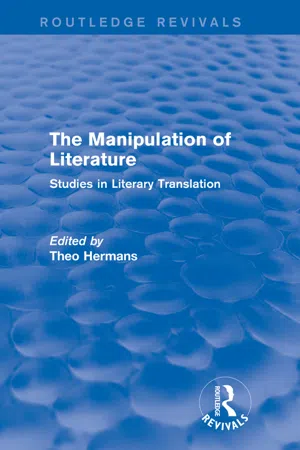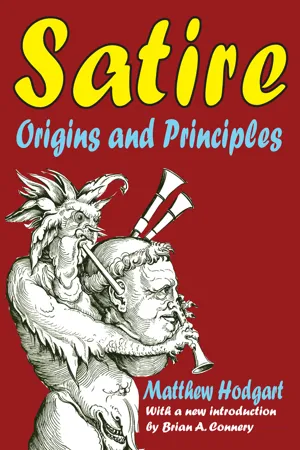Picaresque Novel
A picaresque novel is a genre of prose fiction that depicts the adventures of a roguish, often lower-class protagonist as they navigate through a series of episodic escapades. The narrative typically unfolds in a first-person, autobiographical style and offers a satirical commentary on society. These novels are characterized by their episodic structure, humor, and focus on the protagonist's survival and cunning.
4 Key excerpts on "Picaresque Novel"
- eBook - ePub
The Manipulation of Literature (Routledge Revivals)
Studies in Literary Translation
- Theo Hermans, Theo Hermans(Authors)
- 2014(Publication Date)
- Routledge(Publisher)
...This blueprint will serve as an initial tertium comparationis, underlining both the typical structure of the Picaresque Novel as a story with an open ending, and the cultural and ideological tensions between the picaro and his society. As far as the translations are concerned, my observations relate to the ‘matricial norms’ (Toury 1978:87) of individual versions, taking into account literary as well as socio-cultural factors. The conclusions that can be drawn from this inquiry remain, obviously, limited in scope. Nevertheless, in so far as they are based on various essential ‘textemes’, they offer a clear picture of a common type of translation. By proceeding in this way, that is, treating a particular genre during a particular period, it will be possible to illustrate some aspects of the part played by translations in the spread of a particular genre from one literature to another. The Spanish novela pioaresca is usually defined in terms of a number of formal and thematic characteristics (Van Gorp 1977; Miller 1967; Guillén 1962). As far as the plot is concerned the typical Picaresque Novel presents an episodic story-line, in which events are largely determined by chance: “anything can happen to anyone at any time” (Miller 1967:37). The motifs which steer the plot are mostly of a materialistic nature, although they also touch on the Spanish concept of ‘honour’. They are held together by the central theme of disenchantment and disillusion. As for the relation between the picaro and the world around him: the narrator-protagonist is a lonely figure, a man of poor origin, badly treated even by his social equals, and generally leading a somewhat shady existence. The world he is confronted with is peopled by a series of stereotyped lords and masters and by representatives of all walks of life...
- eBook - ePub
Satire
Origins and Principles
- Matthew Hodgart(Author)
- 2017(Publication Date)
- Routledge(Publisher)
...For a century it remained a purely Spanish genre, perhaps because of a peculiarly Spanish tension between the survival of the medieval and the new colonial economy. The French then began to imitate the picaresque, the most famous example being Le Sage's Gil Blas (1715-35). The genre was adapted for spiritual and metaphysical ends by Johann Jakob von Grimmelshausen in his Simplicissimus (Der abentheurliche Simplicissimus Teutsch, 1669); this classic of German prose describes the hero's search for religious truth in the context of the Thirty Years' War, which is described with satiric realism. Later the genre was imitated, as Cervantes was, by the English comic novelists of the eighteenth century. Smollett's Roderick Random is the purest example of the tough, amoral picaresque. Fielding's Tom Jones belongs to the genre only to a limited degree, since the toughness has been softened by a benevolent and almost sentimental view of humanity; it remains in parts an effective attack on hypocrisy and hardness of heart, as personified by Blifil, Thwackum and Square. The greatest version of the picaresque in the nineteenth century is Mark Twain's The Adventures of Huckleberry Finn, (1884), which is also the outstanding use of the innocent eye in all North American fiction. Twain, rather a crude and facetious humorist when he turned to straight satire (as in A Connecticut Yankee in King Arthur's Court, 1889), produced in the narrative of Huckleberry Finn an extremely subtle and humane indictment of slavery and of the colonial society of the South, in the purest and most expressive colloquial idiom. Picaresque satire depends to a very large degree on a mastery of spoken idiom since any artificiality of diction spoils the effect of casual throwaway comment. This spoken idiom need not be lower-class speech; it can just as well be the conversational style of the upper-class 'barbar ians'...
- eBook - ePub
Knowing Fictions
Picaresque Reading in the Early Modern Hispanic World
- Barbara Fuchs(Author)
- 2020(Publication Date)
- University of Pennsylvania Press(Publisher)
...Cervantes’s own version in the Novelas further develops the picaresque’s skeptical bent. In “La ilustre fregona,” “Rinconete y Cortadillo,” and especially the dyadic “El casamiento engañoso/El coloquio de los perros,” the metaliterary reflection on the picaresque exposes and challenges the complex interplay between narrative authority and belief. Itineraries of the Self Despite announcing themselves as exemplary, the Novelas offer remarkable representations of choice and gusto. Plots often depend on characters who abandon the straight and narrow for the pleasures of waywardness. Romance errancy is thus miniaturized into the space of the novella—or the aforementioned mesa de trucos —as one young man after another chooses to eschew his obligations and explore instead a picaresque version of experience. These itineraries of the (male) self, determined by pleasure and whim rather than necessity or a given social position, problematize the idea that readers can know these figures from any external or preexisting hierarchy. Far from exemplary, their itineraries take the protagonists on a series of highly personal, whimsical detours and ill-advised wanderings across and beyond Spain. Beyond the four novellas that explicitly reference the picaresque lie others whose far from exemplary characters espouse itinerancy, debauchery, or the avoidance of obligation: “La gitanilla,” “El licenciado vidriera,” “La fuerza de la sangre,” “El celoso extremeño,” “Las dos doncellas,” “La señora Cornelia.” (The astute reader will notice that this is most of the novellas, with the exception of “El amante liberal” and “La española inglesa.” Those bear a closer relationship to the captivity narrative, which the picaresque challenges in a different key, as I discuss in Chapter 2.) As critics have noted, in the Novelas the picaresque is often a choice for protagonists, in a version of aristocratic slumming...
- eBook - ePub
- Jorge Téllez(Author)
- 2021(Publication Date)
- University of Notre Dame Press(Publisher)
...Contemporary authors no longer want to be published in Spain, as Fernández de Lizardi desired, but to be translated into English. 1 The main issue at stake here is, of course, colonialism, and to start reading picaresque narratives through this lens I tackle the most important issue in relation to the picaresque itinerary, namely, the presumed spread of the picaresque from Europe to Latin America. THE COLONIAL PICARESQUE Convention tells us that the picaresque is a literary form that crossed the Atlantic Ocean along with the Spanish conquistadors. The most wellknown source for this assertion is Irving Leonard’s classic study on the book trade between Spain and the so-called New World, in which Mateo Alemán’s Guzmán de Alfarache takes a front seat, along with Don Quijote, in the book exportation records of the early 1600s (1992, 264–65)...



